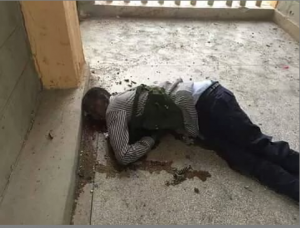
A photo of one the Al Shabaab attackers responsible for Thursday’s attack on Garissa University College. Religious stereotyping can be used as an element for classifying the attach that only targeted non Muslims. (Photo/ Twitter)
Every time I think about the challenges we face as a country in pushing for a culture of ethnic diversity, I cannot help but conclude that it lies in the negative stereotypes we peddle against communities.
Negative stereotypes are to me the main reason why we fought each other in 2007/2008 and are still the reason we still fight each other, unconsciously, sometimes.
We have created an image about each community in Kenya, a lens through which we look and judge. And afterwards we have been so perfect in grading each community and thereafter rewarding it as we wish. I will point out four examples.
We always see the Kikuyu as greedy, so much so that we never appreciate even that which they have acquired something through sweat and hard work. We also see them as a power hungry people who will do anything on earth to remain being the fulcrum around which the presidency rotates.
And the Luo? We see them as a destructive group of people always proud and therefore should be denied power as much as possible. And even more, since culturally circumcision is not their main rite of passage, then we still see them as ‘boys’ who will mess with power.
We then see the Akamba as the ‘black magic’ community, so much so that all that they do revolves around ‘kamuti’ (witchcraft). On top of this we see them as a lazy lot only interested in women and sex.
Then the Abaluhya. We see them as gluttonous, a community that can’t stop at anything until they get their ugali and a chicken on their plates. Like the Akamba, we also portray them as loving sex. Even recently we reported that men in Nambale (a Luhya region) had been promised Akamba women, almost implying that, these two communities can make a match on matters sex.
In a very big way we have allowed these and many other categorizations to guide our inter-ethnic debate. And because of them we usually waste a lot energy.
The Al-Shabaab have also been pushing for a stereotype through which they might divide the country if not addressed well. I may not know much about the meaning of the word ‘Kaffir’ but its alleged constant use during the attacks against Christians is what concerns me. In the way it has been used by terror agents, the word fits as a stereotype meant to profile Christians and present them as valueless.
Stereotyping is a process through which members of one community label members of another community with an intention of taking away their human face. Once dehumanized the stereotyped community is presented as a people fit for attack, even elimination.
This is what happened in Garissa last week and is what has been happening in all attacks, whether terror or ethnic related.
To eat its young ones it is said, the hyena first classifies them as goats, that is, it has to label them as worthy of attack. In fact in doing so the hyena justifies why it ought to kill its young ones – they are goats and goats are meat before the hyena.
We need to work towards neutralizing stereotypes of whatever nature if we are to have a peaceful coexistence. This is what will make us to constantly see a human face in the other tribe and religion. And this is a task that every Kenyan needs to undertake.

